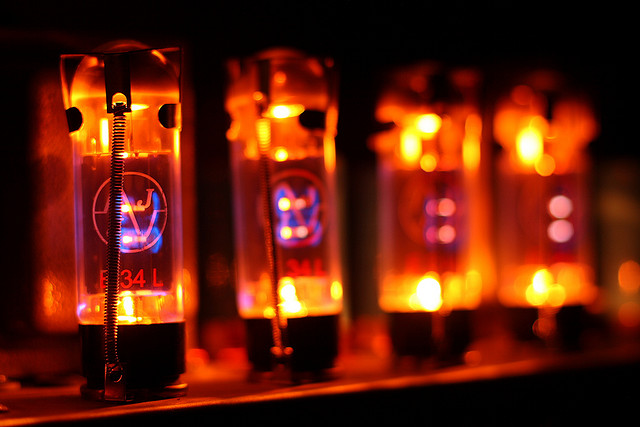
The transistor revolutionized the world and made the abundant computing we now rely on a possibility, but before the transistor, there was the vacuum tube. Large, hot, power hungry, and prone to failure, vacuum tubes are a now-forgotten relic of the very earliest days of computing. But there's a chance that vacuum tube technology could make its way back into computers—albeit without the vacuum—thanks to NASA research that has put together nanoscale "vacuum channel" transistors that can switch at more than 400GHz.
Vacuum tubes have three important components: two electrodes—the negative, electron-emitting cathode, and the positive, electron-receiving anode—and a control grid placed between them. The flow of current between the cathode and the anode is controlled by the grid; the higher the voltage applied to the grid, the greater the amount of current that can flow between them. All three parts are housed in an evacuated glass tube or bulb and look somewhat like a kind of overcomplicated light bulb.
The thing that made vacuum tubes so hot and power hungry was the cathode. Electrons can be encouraged to cross gaps by using very high voltages, but these tend to be difficult to work with. Instead, a phenomenon called thermionic emission is used—heat a piece of metal up enough, and the thermal energy lets the electrons escape the metal. Vacuum tubes have heating elements to make the cathode hot enough to emit electrons.
While vacuum tubes remain relevant to a few niche applications—megawatt scale amplifiers and microwave generators, as well as lower-powered music amplifiers favored by audiophiles—they've almost entirely been replaced by transistors. Transistors are smaller, more reliable, and much less power hungry, and with the development of the integrated circuit, transistors have been miniaturized such that billions of them can fit in the palm of your hand.
NASA's Ames Research Center could be bringing the vacuum tube back, at least spiritually, with vacuum-channel transistors. Two researchers there accidentally built this new kind of transistor when working on a single nanowire, and they wrote a description of what they built for IEEE Spectrum. Vacuum-channel transistors are built on the same idea as the vacuum tube of old: two electrodes (using transistor-style terminology, "source" for the cathode, "drain" for the anode) are placed in close proximity, separated by a vacuum. The flow of electrons from the source to the drain is governed by the voltage applied to what is called the gate.
Unlike the tubes of old, however, NASA's vacuum-channel transistors measure the gap between electrodes, not in millimeters but in nanometers. Making them nanoscale has a couple of key advantages. First, it means that the vacuum-channel transistors don't actually need a vacuum. Vacuum tubes use a vacuum because without it, electrons collide with air molecules, ionizing the gas, which both damages the cathode and lets uncontrolled currents flow. When the gap is small enough, the chance of an electron colliding with a gas molecule is so low that this problem no longer arises. NASA's vacuum-channel transistor uses helium at atmospheric pressure in its gap.
Second, the small scale means that thermionic emission isn't needed any more. Instead, a process called field emission can be used—electrons can be emitted by a cathode simply by placing the cathode in a strong static electric field. This removes the need for the heaters and corresponding power usage.
What makes this vacuum-channel transistor useful? Speed. The switching speed of a transistor is governed by the speed of electron flow through the transistor. Electron flow through traditional semiconductors is quite fast, but electron flow through a vacuum (or, in this case, atmospheric helium) is faster still, and that enables faster switching: NASA's prototype could switch at 460GHz.
That's useful because it could enable the terahertz gap to be filled. It's currently difficult to both generate and detect frequencies from about 100GHz to 10THz. Lower frequencies are amenable to silicon chips and radio hardware; higher frequencies are amenable to infrared and optical technology. The few devices that can operate in this frequency range tend to be large and power hungry. If transistors could be made that worked at these frequencies, the terahertz gap could potentially be filled, and terahertz systems—including medical imaging, chemical detection, and genetic analysis—could proliferate.
The results will not be immediate. NASA still has work to do, both to reduce the operating voltage of its vacuum-channel transistor—currently 10V—and enable mass production. New techniques will need to be invented to package the helium within chips.
Vacuum-channel transistors aren't the only technology that might work at these frequencies, either. Earlier this year, researchers built a silicon-germanium transistor that could switch at 798GHz, albeit at temperatures of 4.3K, or 417GHz at room temperature. Moreover, SiGe manufacturing is already productized, so it may prove a more straightforward path.
reader comments
61